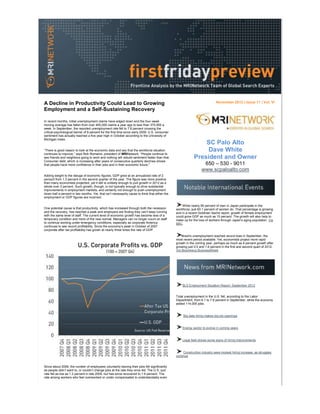First Friday November 2012
- 1. A Decline in Productivity Could Lead to Growing November 2012 | Issue 11 | Vol. VI Employment and a Self-Sustaining Recovery In recent months, initial unemployment claims have edged down and the four-week moving average has fallen from over 400,000 claims a year ago to less than 370,000 a week. In September, the reported unemployment rate fell to 7.8 percent crossing the critical psychological barrier of 8 percent for the first time since early 2009. U.S. consumer sentiment has actually reached a five year high in October according to the University of Michigan index. SC Palo Alto “There is good reason to look at the economic data and say that the workforce situation Dave White continues to improve,” says Rob Romaine, president of MRINetwork. “People continue to see friends and neighbors going to work and nothing will rebuild sentiment faster than that. President and Owner Consumer debt, which is increasing after years of consecutive quarterly declines shows that people have more confidence in their jobs and in their economic future." 650 – 530 - 9011 www.scpaloalto.com Adding weight to the deluge of economic figures, GDP grew at an annualized rate of 2 percent from 1.3 percent in the second quarter of the year. The figure was more positive than many economists projected, yet it still is unlikely enough to pull growth in 2012 as a whole over 2 percent. Such growth, though, is not typically enough to drive substantial improvements in employment markets, and certainly not enough to push unemployment down half a percent in two months. Yet, that isn’t necessarily cause to think that either the employment or GDP figures are incorrect. While nearly 80 percent of men in Japan participate in the One potential cause is that productivity, which has increased through both the recession workforce, just 60.1 percent of women do. That percentage is growing and the recovery, has reached a peak and employers are finding they can’t keep running and in a recent Goldman Sachs report, growth of female employment with the same level of staff. The current level of economic growth has become less of a could grow GDP as much as 15 percent. The growth will also help to temporary condition and more of the new normal. Managers can no longer count on staff make up for the loss of workers through Japan's aging population. Via to continue working under emergency conditions, especially as corporate America BBC. continues to see record profitability. Since the economy’s peak in October of 2007 corporate after tax profitability has grown at nearly three times the rate of GDP. Brazil's unemployment reached record lows in September, the most recent period available. Yet, economists project more rapid growth in the coming year, perhaps as much as 4 percent growth after growing just 0.5 and 1.6 percent in the first and second quart of 2012. Via Bloomberg BusinessWeek BLS Employment Situation Report: September 2012 Total unemployment in the U.S. fell, according to the Labor Department, from 8.1 to 7.8 percent in September, while the economy added 114,000 jobs. Big data hiring makes big job openings Energy sector to evolve in coming years Legal field shows some signs of hiring improvements Construction industry sees modest hiring increase, as struggles continue Since about 2008, the number of employees voluntarily leaving their jobs fell significantly as people didn’t want to, or couldn’t change jobs at the rate they once did. The U.S. quit rate fell as low as 1.2 percent in late 2009, but has since recovered to 1.6 percent. The rate among workers who feel overworked or under-compensated is understandably even
- 2. higher. “Even if a company isn’t cutting its staffing levels, it likely is losing employees to churn at a higher rate today than they were two years ago,” says Romaine. “While though the recession managers might have tried to cover those losses with existing staff, today companies have reached a point where most positions vacated need to be backfilled. If a salary lasted in the budget through the recession, it was a position worth keeping filled.” If hiring is increasing, however, that could very well help add buying power to the economy just in time for the holiday season, giving a possible boost to fourth quarter GDP. The United Kingdom recently experienced a similar situation where employment was growing while GDP was shrinking. The counter cyclical employment growth was puzzling to many economist giving it names like 'the employment paradox' and the 'economic puzzle.' Whatever the cause though, the increased employment likely helped to lift the UK economy out of recession in the third quarter. So whether the dog wags the tail, or the tail wags the dog, 2013 seems to be building the potential for some upside surprise for both the economy and labor market.


